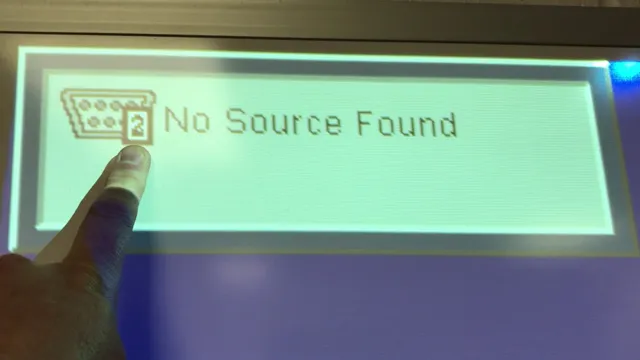Have you ever been in the middle of a presentation or movie night and suddenly, your projector screen turns blue? You’re not alone. Dealing with a blue screen on your projector can be frustrating, but there are ways to troubleshoot the issue and get your display back up and running. It’s just like solving a puzzle, you have to troubleshoot and find the missing pieces to make it work again.
In this blog post, we’ll explore the common causes of a blue screen on your projector and how you can fix them. So, let’s dive in and get your projector display back to its rightful color.
Understanding the Causes of a Blue Screen
When you’re in the middle of a presentation or event, it can be frustrating when your projector suddenly displays a blue screen. This issue often stems from software or hardware failures, and it’s important to address the root cause in order to prevent future occurrences. One common cause of a blue screen is outdated drivers or firmware.
This can lead to errors in communication between the projector and the computer, resulting in a blank blue screen. Another possible cause is overheating or a lack of ventilation. Projectors generate a lot of heat, and if they aren’t properly ventilated, this can lead to operational issues.
It’s also essential to ensure that the cables are connected properly and are not damaged, as this can contribute to potential display problems. By identifying and addressing these potential causes, you can keep your projector running smoothly and prevent any future disruptions during important presentations or events.
Check the Input Connection
When you encounter the dreaded Blue Screen of Death (BSOD), it’s important to understand the underlying causes. One common culprit is a loose or faulty input connection. This can cause intermittent disruptions in the data flow, leading to errors and crashes.
Make sure all cables are securely connected and check for any signs of damage or wear. It’s also worth trying a different input port or cable to determine if the issue persists. While this may seem like a simple fix, overlooking a loose connection can result in continued blue screen errors and further system damage.
So, take the time to double-check your input connections and ensure they’re all working properly to prevent future BSODs.

Check the Cable Connection
One of the causes of the dreaded blue screen of death is a faulty cable connection. It might sound trivial, but a simple loose cable or a cable that isn’t securely fastened can cause havoc on your computer. The blue screen appears when the computer encounters an error that it can’t recover from.
A cable that isn’t properly connected can cause data to be corrupted or lost, leading to a system failure. It’s essential to make sure that all cables are firmly plugged into their sockets. Inspect the pins and connectors to ensure that there is no damage or corrosion.
If you’re still experiencing issues even after checking the cable connections, it’s time to call in a professional to diagnose the issue. Don’t hesitate to ask for assistance; the quicker you fix the issue, the better for your computer’s lifespan.
Check Your Settings
When your computer screen turns blue, it’s not just a minor inconvenience- it’s a sign that something has gone seriously wrong. There are a number of causes of the infamous blue screen of death, which can range from software glitches to hardware failures. But one common cause is settings that aren’t properly configured.
For example, if your computer’s RAM is set to run at a higher speed than it actually supports, that can cause serious issues that may result in a blue screen. Similarly, if your computer’s BIOS settings are incorrect, that can cause stability issues that may lead to a crash. That’s why it’s so important to periodically check your settings, and make sure that everything is properly configured.
Doing so can help you avoid a myriad of issues, including the dreaded blue screen of death.
Troubleshooting the Blue Screen
As a projector user, you may encounter the dreaded blue screen of death. When this happens, it can be frustrating, and you may wonder what has gone wrong. Fortunately, there are several troubleshooting steps you can take to fix this issue.
Firstly, ensure that you have connected your projector correctly and that all cables are properly plugged in. If the problem persists, try changing the input source or checking the resolution settings. In some cases, the issue may be with the projector bulb or lamp.
If you have tried all these steps and still have the blue screen problem, it may be time to contact customer support. By following these steps, you can fix the issue and get back to enjoying your projector. Remember, if you encounter the projector blue screen, don’t panic.
It can be resolved with a bit of patience and troubleshooting.
Power Cycling Your Projector
If your projector is displaying a blue screen instead of your presentation or movie, power cycling may help resolve the issue. Power cycling your projector involves turning it off, unplugging it from the power source, waiting for a few minutes, and then plugging it back in and turning it on. This allows the projector to reset and clear any issues that may be causing the blue screen to appear.
Before power cycling, check the cables and connections to ensure they are secure and properly attached. If power cycling does not resolve the issue, there may be a problem with the projector’s bulb or internal components that require professional attention. By power cycling your projector, you may be able to troubleshoot and solve the blue screen issue quickly and efficiently.
Update Your Firmware
Updating the firmware of your device is one of the most crucial steps in troubleshooting the blue screen. Firmware is essentially the driving force behind your device’s hardware functions. If your device’s firmware is outdated or corrupted, it can trigger a blue screen of death error.
Updating the firmware ensures that your device’s hardware functions are optimized, and any bugs or glitches are patched up. Think of firmware as the “brain” of your device, and updating it is like giving it a “brain upgrade.” It’s an essential step that can fix blue screen errors and prevent them from happening in the future.
Make sure to keep your device’s firmware updated regularly to avoid any potential issues.
Reset Your Projector to Factory Settings
If you are experiencing the frustrating blue screen issue with your projector, do not worry. With a simple reset, you can troubleshoot the issue and get back to enjoying your favorite movies or presentations. Resetting your projector to factory settings will erase any previous settings and configurations that may be causing the blue screen problem.
To do this, locate the reset button on your projector or refer to the user manual for assistance. Press and hold the button until the projector resets, and the blue screen issue should be resolved. By following these easy steps, you can get your projector back to working order and enjoy uninterrupted viewing experiences.
Preventing a Blue Screen on Your Projector
Have you ever been in the middle of an important presentation or movie night, only for your projector to suddenly display a blue screen? Don’t worry, you’re not alone – it’s a common occurrence that can be prevented with a few simple steps. First, ensure that your projector is turned off properly after every use to prevent overheating and technical issues. Additionally, make sure to use a high-quality HDMI cable and check that all connections are secure.
It’s also important to keep your projector’s firmware up to date, as outdated software can lead to glitches and compatibility issues. Lastly, avoid using your projector in areas with high humidity or temperature fluctuations, as this can cause damage to the internal components. By following these tips, you can prevent a pesky blue screen interrupting your next big presentation or movie night.
Regular Maintenance and Cleaning
Regular maintenance and cleaning are essential when it comes to preventing a blue screen on your projector. A blue screen may occur due to a variety of reasons, including a dirty lens, clogged air filter or malfunctioning projector bulb. Performing regular maintenance such as cleaning the lens and replacing the air filter can ensure optimal performance and prevent the blue screen.
It is also crucial to use the correct settings based on the lighting conditions in the room. A well-maintained projector will not only provide better quality visuals but also prolong its lifespan. By taking care of your projector, you can avoid frustrating technical issues, and your audience can enjoy uninterrupted viewing experience.
So, don’t forget to add regular maintenance and cleaning to your projector care routine.
Proper Storage and Transportation
If you want to ensure your projector stays in working order, it’s important to practice proper storage and transportation. A common issue that can arise when the projector is not stored properly is a blue screen appearing. This can happen if the projector’s lamp has been damaged or if there is dust or debris on the lens.
To prevent this, make sure to store your projector in a clean and dry area, away from any sources of heat or moisture. Additionally, when transporting your projector, be gentle and handle it with care to avoid any jostling or impact. It’s also a good idea to invest in a protective carrying case to further safeguard the projector during transportation.
By taking these steps, you can help ensure that your projector stays in good condition and delivers high-quality performances every time.
Conclusion: Fixing and Avoiding Blue Screens on Your Projector
In conclusion, the projector blue screen is like the temperamental diva of the audiovisual world. Just when you think everything is going smoothly, it decides to steal the show and hog the spotlight. But fear not, for with a little troubleshooting and a touch of patience, you can coax the blue screen back into the background where it belongs.
Just remember, even the shiniest stars have their off days – and sometimes, even the plainest screens can surprise you with their luminosity.”
FAQs
What causes a blue screen on a projector?
A blue screen on a projector can be caused by a number of factors, including a loose connection between the device and the projector, a damaged cable, or a problem with the projector’s settings. Try checking all connections and adjusting the projector’s settings to see if that resolves the issue.
How can I fix a blue screen on my projector?
To fix a blue screen on your projector, first check all cables and connections to ensure everything is properly connected. Then, try adjusting the video settings on the projector to see if that resolves the issue. If the problem persists, it may be due to a faulty projector or cable, and you may need to seek professional repair or replacement.
Is it normal for a projector to display a blue screen when there’s no input?
Yes, many projectors are designed to display a blue screen when there is no input signal detected. This helps prevent damage to the projector and prolong its lifespan by reducing the amount of time it spends displaying a static image.
How can I prevent a blue screen from appearing on my projector during presentations?
To prevent a blue screen from appearing on your projector during presentations, make sure all cables and connections are properly secured before beginning your presentation. You can also adjust the settings on your computer or other device to ensure that it does not enter sleep mode or turn off the display during the presentation. Finally, consider investing in a high-quality, reliable projector to minimize the chances of technical issues during important presentations.
